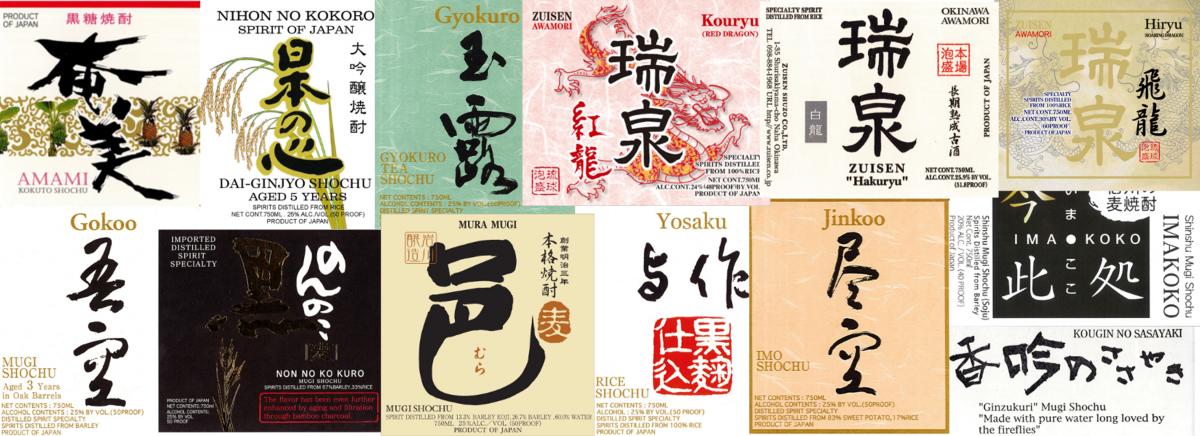
Shochu is Japan’s indigenous spirit. Unlike sake, shochu is a distillate and typically possesses a higher alcohol proof around 50, but can be as high as 80. Shochu is most commonly distilled from barley, sweet potatoes, rice and sugarcane. Notwithstanding, there are approximately 50 varieties of raw ingredients are utilized by the shochu industry. Shochu production is characterized by two types of distillation techniques; (1) honkaku (otsurui) – single-distillation method whereby the liquid resulting from a single pass through typically a pot still is bottled and (2) korui – continuous distillation method resulting from multiple passes through typically a column still. A majority of the shochu exported to the US is produced via the single-distillation method.
The distiller’s objective in producing honkaku shochu is to celebrate and showcase the flavor of the raw ingredient. (Barley, Imo, Rice, Green Tea, Sugarcane, Carrot, etc.).
A vast majority of shochu distilleries, approximating 300 of the nearly 500 total are located on Kyushu Island, the southernmost of the major Japanese islands. These 500 distilleries produce roughly 5000 brands.
Typically shochu tends to possess a lower caloric value compared to other spirits. Some of this can be attributed to the generally lower average alcohol content, however, the ratios tend not to be proportional:
Caloric Comparison:
Shochu – Average ABV – 25% = Average of 25 Calories / Ounce
Vodka – Average ABV – 40% = Average of 64 Calories / Ounce

Although often vigorously debated by producers, it is widely alleged that shochu was first born around the mid-16th century in Kagoshima. Respective factions in Okinawa and Fukuoka also lay claim to the birthplace of shochu distillation being within their prefectures. Each account seems to agree that distillation was practiced in Japan somewhere between the late 15th and mid 16th century. From the mid-16th century through the Edo era, shochu was exclusively produced via the single distillation method. The continuous distillation method utilizing a column still was developed in 1910 with the import of new distillation technology from Great Britain during the Meiji period.
WTO Regional Appellations for Shochu:
Satsuma Shochu (the former regional identifier for Kagoshima Prefecture) – The imo (Japanese Sweet Potato) and water must originate in Satsuma and the production must complete occur within Kagoshima Prefecture utilizing kome (rice) or imo koji.
Kuma Shochu (Kumamoto Prefecture) – Must be 100% rice shochu and water utilized must be dervied form the Kuma River.
Iki Shochu (Nagasaki Prefecture) – Must be 2 parts mugi (barley) to 1 part kome (rice).
Ryukyu Awamori (Okinawa) – Must use Thai Rice (long grain indica) and kuro (black) koji with a single fermentation.

Koji Production:
Much akin to the sake production process, the base raw ingredient is milled or peeled, washed, soaked and steamed prior to being spread out to dry and undertake koji spore application. In shochu production, 3 types of koji spore are widely used; (1) White Koji – Light and MIld; (2) Black Koji – Bold and Rich; (3) Yellow Koji – Aromatic. The use of Black Koji was predominant until the early 1900s when White Koji, thought to be easier to handle, widely grew in use. Currently, there has been shift back towards Black Koji use. Koji is applied to the prepped base ingredient and left to propagate. (2 Days)
Multiple Parallel Fermentation / Heiko Fukuhakko:
Unique process to shochu and sake production. The process entails that while some starches are being converted to sugars (by the enzyme catalyst – Koji), other sugars are converted to alcohol by the yeast. This typically leads to a higher alcohol by volume pre-distillation.
First Mash Production / Primary Fermentation / Ichiji Shikomi:
The koji, water, and yeast are mixed together and let to rest. This allows for the cultivation of a large colony of yeast resulting from the aid of the koji in the saccharaification process. (5-10 Days)
Second Mash Production / Secondary Fermentation / Niji Shikomi:
Mix the first mash with the raw ingredient, water, and leave to rest.
Distillation:
Extraction of alcoholic properties from a fermented compound through a process of boiling, selective evaporation and condensation. Honkaku shochu is limited to one distillation pass through the still. The theory is that limiting the distillation to one pass results in a truer aromatic profile versus a largely muted aromatic profile that results from multiple distillations.
Honkaku (otsurui) – single-distillation method whereby the liquid resulting from a single pass through typically a pot still is bottled
Korui – continuous distillation method resulting from multiple passes through typically a column still.
A majority of the shochu exported to the US is produced via the single-distillation method.
Distillation Types:
Atmospheric – Normal Pressure Distillation – Joatsu: a method of distillation where heat is applied to the mash to separate the water from the alcohol, along with congeners, through evaporation and condensation.
Vacuum – Low Pressure Distillation – Genatsu: a method of distillation where the pressure applied to the mash is less than the pressure necessary to vaporize. This causes evaporation of the liquid with the lowest boiling point.
Maturation:
Maturation of the shochu can be achieved in stainless steel or enamel tanks, earthenware pots, or wooden barrels.
In Awamori production, aged awamori known as Couth or Ku-su has a prescribed aging period of 3 years.
Blending / Diluting / Bottling / Dispatch:
The Aged Genshu (undiluted distillate) is then blended and diluted with water to achieve the target alcohol by volume prior to bottling; typically around 25% ABV.
